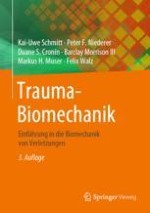2020 | OriginalPaper | Buchkapitel
11. Ballistisches Trauma und Verletzungen durch Explosionen
verfasst von : Kai-Uwe Schmitt, Peter F. Niederer, Duane S. Cronin, Barclay Morrison III, Markus H. Muser, Felix Walz
Erschienen in: Trauma-Biomechanik
Verlag: Springer Berlin Heidelberg
Aktivieren Sie unsere intelligente Suche, um passende Fachinhalte oder Patente zu finden.
Wählen Sie Textabschnitte aus um mit Künstlicher Intelligenz passenden Patente zu finden. powered by
Markieren Sie Textabschnitte, um KI-gestützt weitere passende Inhalte zu finden. powered by
